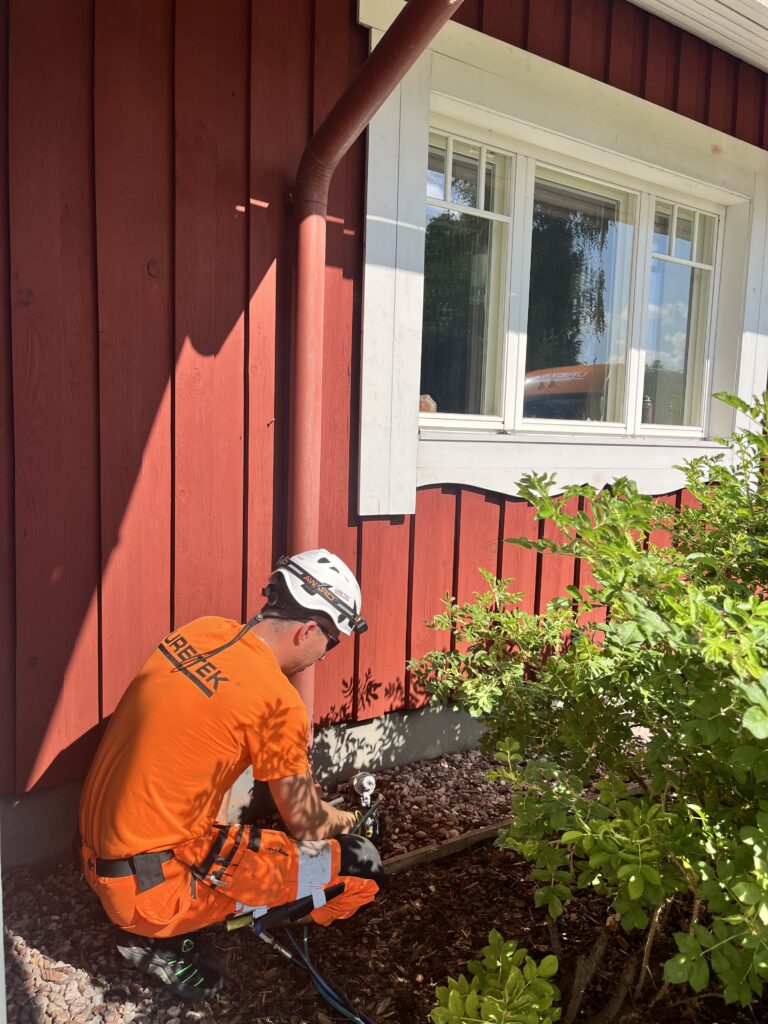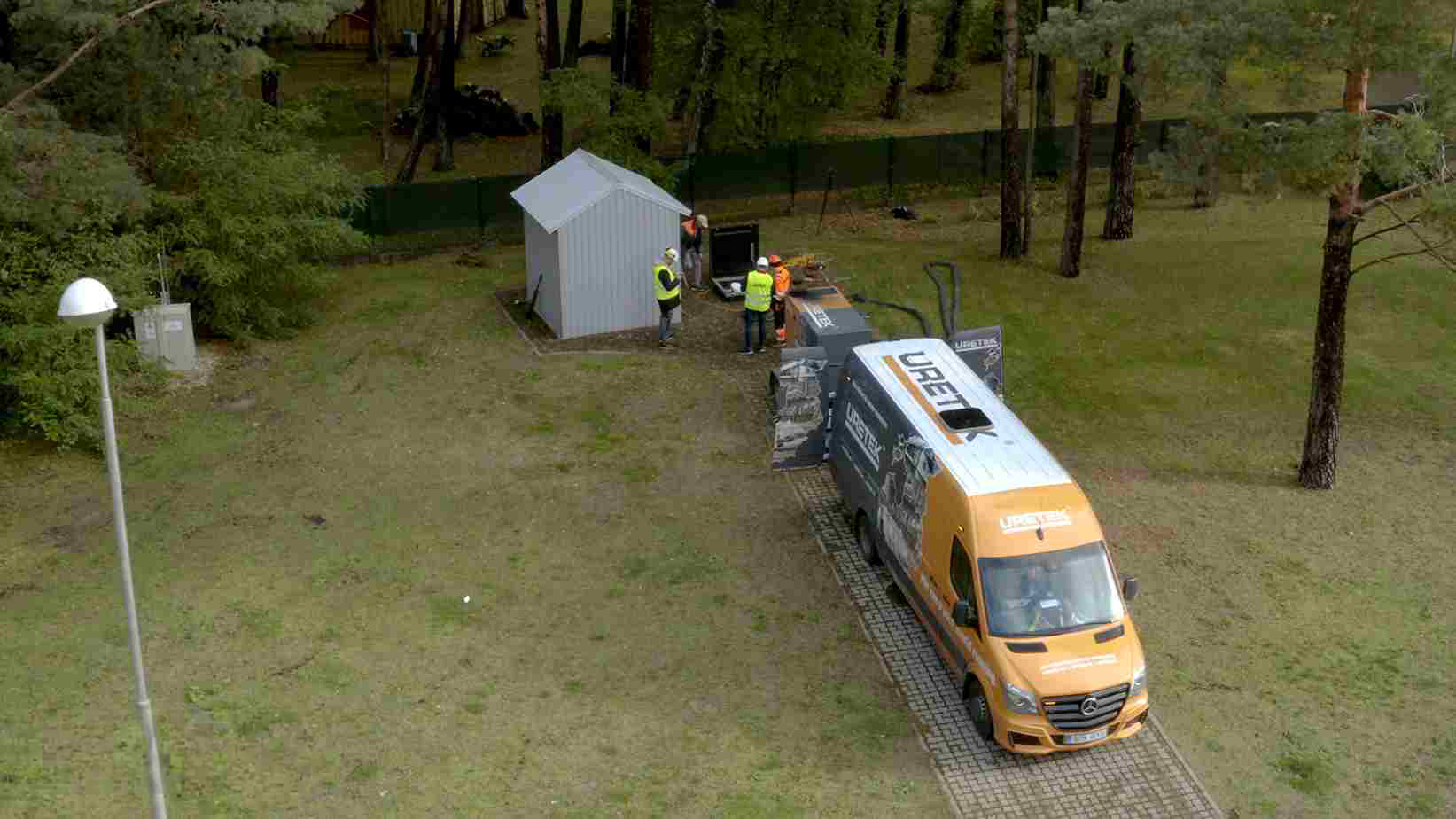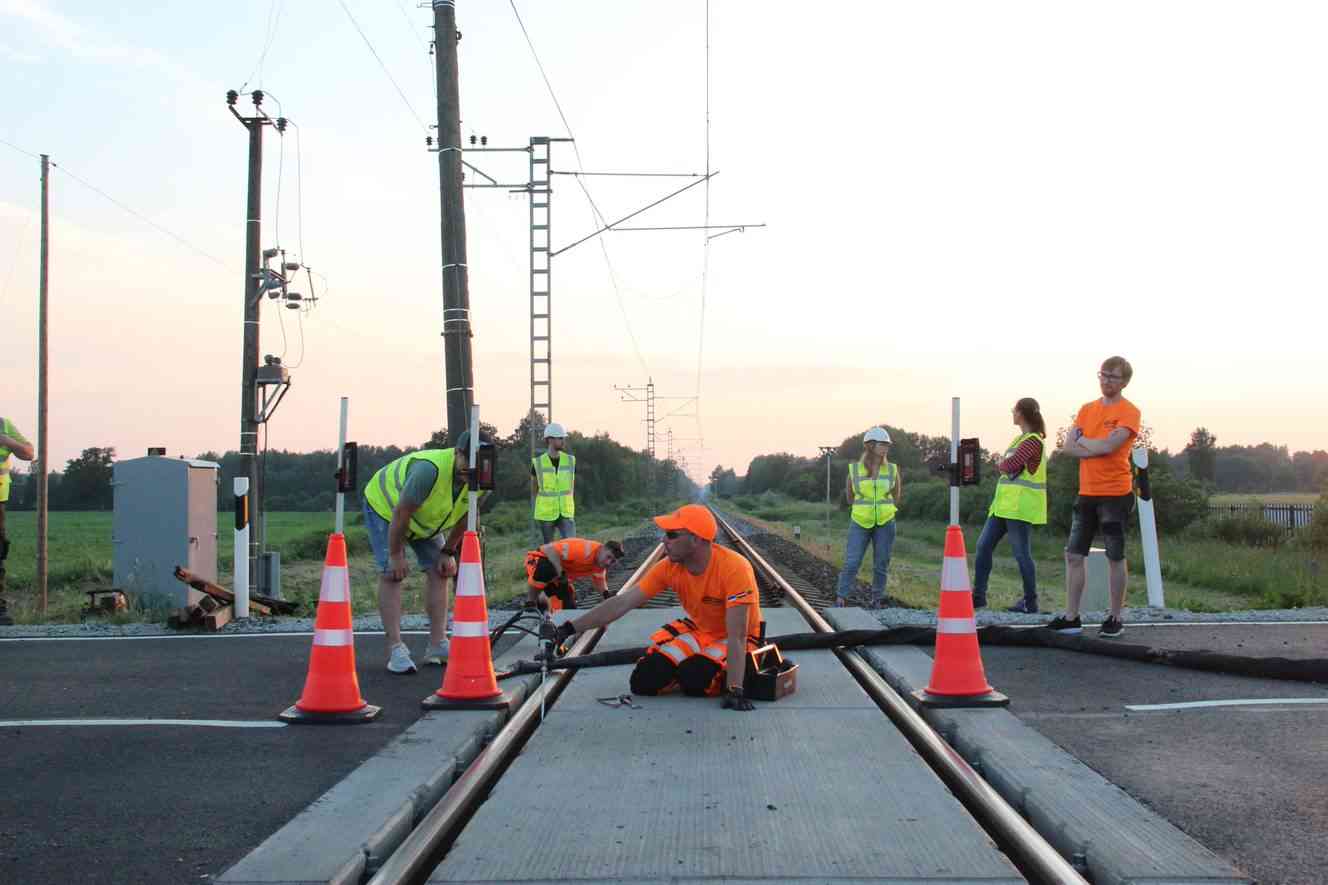Kevin
Soil compaction and foundation stabilization of the Riga Cathedral, a UNESCO World Heritage Site
Keywords
Subsided concrete floor relevelling and soil stabilization of Rimi shopping center
Keywords
Jurmala city sewerage collection well stabilization and hydro isolation
Keywords
Stabilisation and re-levelling of the concrete floor of the Rimi shopping center
Keywords
Авторемонтная мастерская в Сихва
Keywords
Soil compaction and leveling – an important step to prevent the building from subsiding
The foundation is one of the most important, if not the most, part of a building. The entire building relies on the foundation, and its durability determines the durability of the entire thing. The foundation of the building has to be built so that it withstands the weight and load of other elements. A building’s and its foundation’s construction starts with preliminary work, which can not be ignored.
Preparing the soil by its compaction and leveling, is an important part of the construction process. This gives it the required flat base that offers an important support not only for the building, but for roads and other different building constructions as well. The compression process gives the soil, that is under the foundation, a bigger endurance and stability. It is important to know why this process requires careful attention and what could happen, if this step is skipped or carelessly executed. And most importantly- how to deal with consequences that have occurred from poorly compacted and leveled soils.
What is soil compaction?
The majority of constructions are supported by soil that is underneath them. To enable construction of a building or other facility, air and water particles must be removed from the soil and then it has to be leveled. That way the treated soil can sufficiently and firmly support the construction.
Soil compaction means increasing the density of soil, sand or some other solid soil layer by pushing out water or air from it. This is done by applying load to soil with the help of mechanical means. This way the soil’s volumetric weight and carrying capacity increases, which ensure the load receptivity coming from the building.
The compression’s main goal is to increase the shear strength and the related load capacity. Through the process however, the stiffness of the soil is also increased to prevent future deformations, for example through moisture content and frost.
The result from the compressions depend on many different factors such as:
- The nature and type of the soil – it can mean compositions from sand, clay, soil or granular;
- The thickness of the compacted soil layer;
- The moisture of the soil;
- Time, that is spent on compaction;
- Of the work that is done for compaction- the weight, type, vibration, number of repetitions etc of the used device
What is soil leveling?
Soil leveling, as the name itself says, means leveling the ground, to remove bumps, dimples or other bigger unevenness. The operation is carried out in the preparation phase of the new construction project.
One of the main purposes of soil leveling is to protect the foundation from water damages. Leveling the soil under constructions or around it, ensures water from flowing away from the building and not into the soil layer under the foundation. If the soil layer is not leveled or is poorly done, the water can flow towards the house. This can gather around the foundation and saturate the surrounding soil, causing the building to become unstable.
Afterwards, it is possible to carry out soil work around the house. For instance on properties, where the missing drainage ruins the foundation, leveling the soil can repair the situation.
Why is soil compaction important?
If proper geological studies were not done before building a house and the house is built on a weak land, or the land has been poorly prepared before building a foundation, as in compacted and leveled, it can lead to the process when the soil as well as the house start to subside.
A subsidence is a process that is a result of the environment, as a result of substandard works or due to changes in the soil, the building’s foundation could move downwards. Land subsidence can be caused by geological, manmade or seasonal reasons:
- High spring waters can wash away a lighter layer of soil, such as sand;
- Bigger trees that grow near the foundation can, especially during hotter periods, suck out moisture from the soil so much that it could cause the soil or other soil layer to contract;
- Water that has flown out from a broken or leaking sewage, can sometimes soften or even wash away the ground surface, resulting in a movement of the ground and therefore the building;
- If a building is near a high traffic area, the strong vibrations coming from it could lead to ground movement.
- Foundation works, that have been done with poor quality, could cause subsidence problems, especially during water damages.
Although, reasons why a house’s foundation or floors subside are different, they are still frequently caused from the very first building steps. For this reason, it is very important to be cautious about the soil’s compaction and leveling.
What does house subsidence entail?
Different cracks in the inner and outer walls, gaps between the floorboards and the walls, sloping or partially sunken floors, slanted or jammed windows and doors are just a few concerns that subsidence can bring up.
Over time subsiding foundation can bring up serious problems:
- Damages to walls and floors are harder to repair or they are even irreversible;
- Cracks that have become bigger and bigger over time allow wind and moisture to enter the house, causing mold over time;
- Heat loss increases, the dwelling is colder and as a result the energy efficiency of the building decreases;
- Water and heating pipes can break;
- Malfunctions of electrical installations can occur.
Problems that are caused from the house’s or foundation’s subsiding are expensive. A lot of money is frequently spent on repairing damages, but the core of the problem is not dealt with and no work is undertaken to stabilize the foundation.
How to deal with the consequences of poorly compacted soil?
If for any reason the foundation of the house has begun to subside and as a result the whole building has started to do the same, the problem must be dealt with as soon as possible. Then neither the soil leveler nor the surface hardener will help, you have to approach subsidence in a different way.
Stopping the house from subsidising and restoring the foundation using conventional methods is a time consuming and resource-intensive job. Solving the problem with the outdated approach means emptying the rooms, breaking up and removing the concrete floors, compacting the soil and pouring new floors. This puts the owner of the house in front of a difficult question- should they start a time- and money consuming process that forces them to be away from home for a long time, or postpone the solution of the problem into the indefinite future, knowing that the situation will constantly worsen? This way it seems like the only thing left is to make a bad or worse choice.
If only there was a solution that thickened and stabilized the building quickly and cleanly and would not need additional preparations such as moving out of the house and replacing furniture. What if the cracked walls and cracks between walls and floor tiles could be fixed in a day, without waiting for the new concrete to harden? Seems too easy of a solution to be true?
How can URETEK Baltic help?
Works performed by the soil improvement enterprise URETEK are, due to their innovative technology, a highly valued alternative for raising and restoring building foundations or floors. This does not require excavation or demolition, thus contributing to both human comfort and environmental protection. Also the technology developed by URETEK does not cause vibrations or disturb nearby buildings.
URETEK uses injection technology of geopolymers, which allows it to approach the mentioned problems in a new and convenient way. URETEK offers a technological solution, with which two component geopolymer resins inject the ground. The nature of the problems in soil, which is the cause of subsidence of the foundation and floors, is reached through a 12-32mm wide borehole and an ecologically neutral resin or geopolymer resin mixture is injected into it. The resin is inserted into the soil where it expands until it hardens, filling all the voids and cavities in the soil. Under the influence of resin injection, the house or other structure rises up and moves back to the original designed height. The soil layer is compacted and thereby ensures the stability of the building.
It is not required to move out of the house or even move furniture for this type of procedure. Daily use of the building may continue during the works. Usually it only takes one to three days to complete the work and the work site remains clean and dust-free.
Get in touch with us and we will stop your buildings from subsiding.
Keywords
Lifting and levelling of aerodrome surface covers
The covering of taxiways and take-off and landing runways on aerodromes may sink
When using classical methods, restoring damaged sections along with strengthening the subsoil and replacing cover plates takes several weeks or even months, during which aerodrome cannot operate at full capacity. When using URETEK materials, restoration works take only a few days or even just a few hours.
Subsidence of aerodrome concrete slabs is a common problem in many airports across the world. Aerodrome surface slabs may be subject to subsidence due to increased volume of passengers and cargo, deteriorated drainage system, natural wear and tear of materials, etc.
Subsidence of concrete slabs within permitted limits is not dangerous and does not cause accident-prone situations. But if the weakening of soil under the aerodrome and subsidence of certain runway sections exceeds permitted limits, immediate intervention is required. Even if the condition of aerodrome cover slabs is not yet unsafe, it may lead to danger situation in case of sudden change in weather conditions. For instance, if water in the recesses of aerodrome surface freezes, it may cause planes to slide.
Strengthening of the soil under airfield
In order to restore concrete slab surface of aerodrome, it is necessary to strengthen the soil under the slabs. Traditionally, stabilisation and levelling of aerodrome surface slabs requires partial or complete dismantling, closing unsafe section for major repairs and involving heavy duty vehicles. After dismantling of the slabs, soil strengthening procedures are performed, followed by restoration of aerodrome surface.
When using modern URETEK technology and materials, it is not necessary to dismantle or replace the aerodrome surface in order to strengthen the soil under aerodrome and stabilise and level the position of concrete slabs, neither is it necessary to deploy heavy machinery.
For strengthening the soil, a certain number of holes with 16 mm diameter are drilled in aerodrome surface used for inserting geopolymer material to required depth.
Principle of the technology
URETEK material contains special geopolymer resins, which expand and harden when inserted in soil, achieving great strength in merely 15 minutes. That way, the soil under the airfield is strengthened, whereas restored section can be used almost immediately after performing the injections.
Technology allows restoring the site with only minor changes in flight plan that do not interfere normal functioning of the aerodrome. It is sufficient to plan repair works for the period when there are not many take-offs and landings. Due to the dimensions of equipment required for URETEK geopolymers injection and autonomous nature of transport equipment, it does not limit the aerodrome resources during restoration works.
Variations in technology
URETEK technology can be used in two ways to lift and stabilise airfield cover plates. Methods differ from each other in terms of the depth of geopolymers injection. Deep Injection method is used to restore former soil properties at the depth of several meters. For immediate stabilisation and levelling of concrete slabs, geopolymer material is inserted in the gap between soil and slab by using Slab Lifting method. In both cases, the position of aerodrome surface and concrete slabs is adjusted by means of laser levels with precision of ±1 mm.
Keywords
Stabilisation of railway tracks
URETEK geopolymers injection technology allows repairing railway embankments in the shortest time, while not affecting train traffic
Geopolymer resins help to strengthen and stabilise sunken crushed stone layer, also level concrete slabs of railway tunnels, stations, crossings and depots and lift them to designed height where necessary.
Railway infrastructure consists of many objects, including sections with railway tracks, tunnels, bridges, stations, depots, repair workshops, etc. All these objects suffer from loads caused by train traffic, as well as weather conditions and surface water.
Construction regulations prescribe establishment of groundworks consisting of crushed stone before installing rails. Railway embankment is made of bulk material (e.g. crushed stone). Regular load on rails and crushed stone causes uneven subsidence of different track sections. When subsidence exceeds maximum limits, the position of rails changes and using the tracks becomes unsafe. By using modern URETEK geopolymers injection method, it takes only a couple of hours to restore safe condition of tracks and strengthen crushed stone layer.
Stabilisation of crushed stone layer of railway embankment
Using geopolymers allows strengthening of soil under railway tracks and stop subsidence of crushed stone layer without dismantling rails and sleepers. Meanwhile, stabilisation of railway embankment does not require adding crushed stone. It is sufficient to insert geopolymer resin directly in railway embankment or the soil under it. Geopolymer material expands and exerts pressure vertically, thus lifting the tracks to their designed height.
Lifting of reinforced concrete slabs
In several sections (crossings, tunnels, stations, depots, etc.) tracks are mounted on reinforced concrete slabs. Such slabs can also sink due to changes in surface water level or soil erosion resulting from disruption of drainage systems.
Sections with concrete slabs can also be levelled and stabilised, using URETEK technology to strengthen subsoil. For that purpose, geopolymers are injected through holes drilled in concrete slabs. Meanwhile, there is no need for dismantling slabs and railway embankment. Soil deep under reinforced concrete slab is strengthened by using Deep Injection method, slabs are lifted and levelled by using Slab Lifting method.
Specifics of geopolymers injection
For injection of geopolymers, holes with diameter of 12–16 mm are drilled in crushed stone layer of railway embankment or in reinforced concrete slabs. Geopolymer material is inserted through hoses into pipes with diameter of 8–14 mm. Immediately after injection, geopolymer material expands, filling cavities and voids in soil and thus ensures lifting and stabilisation of structures. The process of lifting is monitored in real time by means of laser level.
Geopolymer achieves required durability in only 15 minutes. This allows quick completion of all works without altering train schedule.
Keywords
Levelling and repair of roads and parking lot surface
Geopolymer resins injection technology gives an opportunity to repair concrete road surface in a very short time
Geopolymers allow strengthening the soil under concrete road slabs and also lift sunken elements and adjust their position.
Constant use of roads causes deterioration of their condition over time. Roads are affected by dynamic loads caused by heavy duty vehicles, but also by various environmental factors.
Concrete slabs used in construction of roads and parking lots may sink and create accident-prone situations. Such places are most common on high-traffic roads, parking lots, manoeuvring spots and loading areas. In that case, roads need repair, which can be performed by using URETEK geopolymers injection technology.
Injection under concrete slabs
For restoring the concrete slab pavement, it is recommended to use geopolymers injection method Slab Lifting. This allows lifting sunken concrete slabs, but also level and adjust entire pavement of road section or parking lot. Slab Lifting method makes it possible to repair unsafe road sections adjacent to bridges, railway tracks, docks, loading bays, etc.
Slab Lifting method is much more efficient than traditional road repair methods, because geopolymer resins resist dynamic load well. It is also important that when using geopolymer resins, it takes only a few hours to a couple of days to restore the surface of roads or parking lots.
Meanwhile, works can be performed in stages, without closing all lanes and at the most convenient time, when road traffic is minimal.
Road section repaired using geopolymers can be used even by heavy duty vehicles already 15 minutes after completion of works. As a comparison, restoration of road section with concrete pavement, including dismantling and reinstalling of slabs can take weeks and even months.
Deep strengthening of soil
Geopolymers injection technology allows to restore concrete surface of roads and parking lots as well as strengthen the soil under the road. For that purpose it is best to use Deep Injection method. In that case geopolymers are used for increasing the load-bearing capacity of soil. Deep Injection method can also be applied to construction of new roads and highways. When geopolymers are inserted in excessively humid soil, they force excess liquid out and thus increase the load-bearing capacity of soil.
Work process
For lifting roads and stabilisation of pavement by using geopolymers, only a few holes with diameter of 12–16 mm are necessary for injection.
Injection is performed through special pipes inserted in drilled holes. When reaching soil layer or under concrete slab, geopolymer material extends, fills void and cavities and strengthens weakened soil, forces water out and lifts sunken concrete slabs gradually upwards. Lifting is monitored by using laser level with precision of up to ± 1 mm.





















